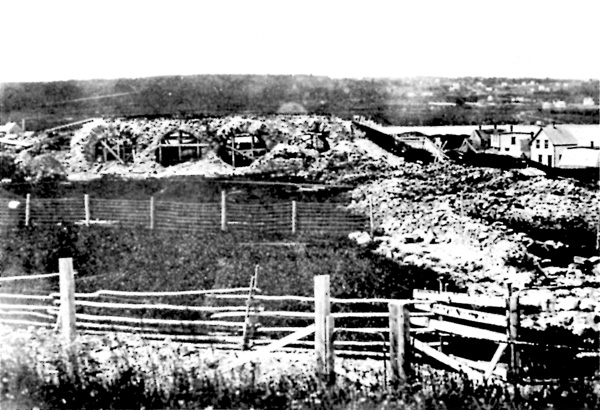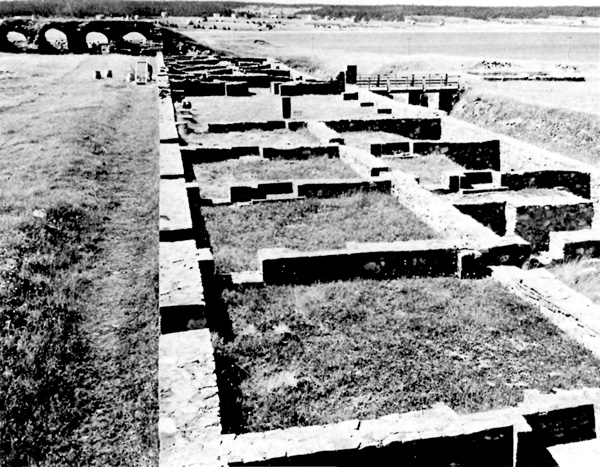|
|
 |
Canadian Historic Sites: Occasional Papers in Archaeology and History No. 18
The Construction and Occupation of the Barracks of the King's Bastion at Louisbourg
by Blaine Adams
French Occupation: 1749-58
The French official sent to re-establish control over the colony was
Commandant Desherbiers, who arrived in June of 1749. Arrangements were
soon completed with the English, who remained in the barracks while the
French came ashore; the English then boarded seven of the same ships and
were returned to New England.1 The original plan for
reoccupation called for the soldiers to occupy the New England barracks
and for the townspeople to temporarily use the barracks of the King's
Bastion while waiting to move into their town houses or to go to the
outposts;2 however, it was not until 1754 that the French
barracks resumed its role as soldiers' quarters.
Commandant Desherbiers did not take up residence in the governor's
wing of the barracks but lived in the engineer's house since there was
no chief engineer at this time.3 The governor's wing was much
out of repair, especially the ground floors which required new beams.
Repair documents refer to the ground floor containing a council chamber,
antechamber, vestibule and kitchen.4 The dining room was
mentioned when a two-piece buffet with cornice and shelves was added to
the room, as well as two large trestles for a buffet table. In 1750 two
iron stoves were added to the wing in the perennial fight against
dampness.5
There were asserted occupants of the governor's wing in the first
years of reoccupation, with the king's lieutenant residing there in 1749
and the noted French geographer, Joseph Chabert, in 1750. The latter had
been sent out to make readings of the stars and tides in the North
American colonies, and he had built a wooden observation shack on the
left flank of the King's Bastion to which he had access from the
governor's balcony.6 Chabert left Louisbourg in 1751, but the
new governor, M. le compte de Raymond, declined to move in. "Cest une
vraye glacier," he reported, "estil n'y a aucune commodité qui puisse
convenir àl'état de ma maison."7 He, too, lived in the
engineer's house, and that winter the wing was occupied by some naval
officers whose ship wintered at Louisbourg for fear of an attack on the
colony in the spring.8
Two lists9 of occupants in the barracks in 1752 and 1753
reveal that the building was given over to both civilian and military
occupation. Inevitably, personal relations were strained at such close
quarters, and in May the ordonnateur wrote that a new engineer,
Brécon, and his two sons, who were sub-engineers, were guilty of bad
conduct. The father was living with a woman de mauvaise vie and
was waiting for a second "qu'on dit veuve d'un officier Irlandois." This
ménage was living in the governor's wing and even wanted to make
alterations which the ordonnateur prevented.10
Other barracks residents had been forced to leave the colony,
including three women "of bad life" and "plusieurs families of Irlandois
qu'on aèté obligè de chaser du pays." Aside from the notorious Brécon
and his sons, two captains and their families lived in the governor's
wing. In the officers' quarters there were more captains with three
rooms set aside for the church and occupied by the chaplain, the verger
and the sacristy. Another room housed a pensioner. Some of the rooms in
the soldiers' barracks were given over to officers, but most were
allocated to married soldiers. One soldier was in the same room as a
woman of "bad life," but she had disappeared by the time the second list
was compiled in 1753. Other rooms were allotted to sailors, the school
for cannoneers, and the contractor; two were set aside for the
government and one was vacant. In the north wing four rooms were
occupied by a Captain Benoit and his family, and the other four by a
captain, an ensign and his wife who had two rooms, and a widow sans
profession.
It is not possible to discern on what basis the rooms were allocated.
In some instances captains had only one room while the ensign, much
lower in rank, had two. A number of civilians also had rooms to
themselves. As well as listing the occupants of the rooms these
documents did give some interior details. The governor's wing was
described as "Vaste, ben et Commode" with two rooms for the council and
kitchen on the ground floor, and an office, large antechamber,
bedroom, cabinet, wardroom and private staircase on the first
floor and three attic rooms for servants. It was felt by the author that
the wing had other advantages:
Le rampart du bastion du Roy peut lui servir de promenade que le
jardin commun entre luy et L'Ordonnateur, est Situé vis a vis Quil y a
une grande Cour pour la Volaille avec Ecurie, remise, et Pigeonnierre Et
qu'enfin Si la Cour adopte le projet formé pour Effacer le Chemin
Couvert de la Gorge du fort, on pour[ra] y procurer une Entrée de face a
la place d'Armes.
The plan for a townward entrance to the governor's wing did not
materialize. The north wing was still referred to as the "Ancienne
Intendance" and it was described as having eight rooms which could be
turned over to the king's lieutenant for his residence, with the
adjoining casemates to be used as storage areas. The rest of the
building was referred to simply as the barracks. It was recommended that
three rooms be set aside for the sacristy, chaplain and prison; that two
be set aside for the government; and that the remaining 31 serve as
officers' rooms with one room for subalterns and two for captains or
married officers. This recommendation was never carried out because of
the officers' reluctance to leave their town dwellings.
In the spring of 1754, a third commander was appointed to Louisbourg,
Governor Augustin de Drucour, who, with his wife, took up residence in
the governor's wing which had finally been readied for his occupancy.
The arrival the following year of 1,050 soldiers and 62 officers of the
second battalions of the Artois and Bourgogne regiments meant that all
available space would be used for barracks. The north half was finally
returned to its original function and was to house 324 soldiers and 2
captains. The south half, however, was left to be occupied by the
government, chapel, chaplain and "Le Capitaine des portes."11
By means of rented housing near the barracks of the Queen's Bastion, all
the troops were finally lodged.12 The newly arrived officers
did not expect or want barracks accommodation, and the engineer Franquet
complained that they were expecting to get what they had in France,
forgetting that this was a place of war where they had to accept what
was provided.13 The ordonnateur, Prévost, went so far
as to suggest that the officers be forced to go into the quarters
provided for them;14 however, as mentioned above, the army
officers were much more effective than the Marine in getting
their lodging suitably furnished.
Little is known about the occupation of the barracks of the King's
Bastion until the second Louisbourg siege. In 1758 two additional
battalions from the Combis and Volontaire étrangers regiments
added 1,360 troops to the rolls and the accommodation problem must have
been acute. There is some evidence that the courtyard of the bastion,
along with the chapel, was turned into soldiers' quarters.
On 8 June the second siege of Louisbourg began and the building
suffered severe damage from enemy artillery and mortar fire.
A sept heures ce matin [of July 23] ii a tombé sur les Cazernes du
fort au Nord du Clocher de la Chapelle une Bombe de 12 Pouces dans une
Chambre de Soldats, ces Soldats ont tous Sortes emportant leurs effets,
on S'est presenté pour visiter si elle y avoit mise le feu mais on n'a
pas cru qu'il y étoit, une demie heure apres le feu a paru tres allume,
il s''en communique rapidement le long du faîtage, et de la couverture
en Bardeau; on a fait des efforts pour le couper au dessus de
l'Eglise;... mais les vents ayant changés dans ce moment, L'Incendie a
enfilé la longeur de ce Batiment, Il n'a pû être arrêté qu'au Pavillon
du Sud logement de M. do Drucour Gouverneur de cette Place, tous le
reste y compris le Pavillon de l'autre Bout à été consumé.
Les Anglois Pendant ces incendie qui a duré cinq à Six heures ont
faits pleuvoir dans cette partie des Bombes et des Boulets avec une
extreme activite. Neanmoins toute la garnison, des ouvriers de la ville
et les Charpentiers des Vaisseaux s'y sont porter avec une Bravoure, et
une ardeur peu commune.15
A second account of the fire described the scene in the building and
in the yard on that disastrous morning.
Une bombe y tombe [on the barracks], éclate, tue of blesse huit
personnes, une seconde remplie d'artifices, vomissant des flammes par
cinq bouches, y met le feu, déjà une grande partie de cet édifice est
embrasé, les flammes sortent do toutes parts et montant jusqu'aux nues
présentent un simulacre du volcan; à ce spectacle d'horreur se joignent
les gémissements, les cris des femmes des enfants, le feu avait entamé
les bois et blindages qui couvriaent l'entrée de leurs casements, une
fumée noire et epaisse avait pénétré. Cette odeur empestée les
réveillant, la crainte d'être brulées les précipitant hors de leur lit,
à la hâte elles quittent ces' asiles enterrés, et se sauvent en foules
les unes vêtues en simple jupon, la plus grande partie d'un seul linge,
l'une enserre sa fille, l'autre porte son fils, celle-ci en a deux
crochetés dans ses bras, un troisième la suit, et cette autre aidée
[illegible] porte of traine son corps.
Once out of the casemates the only exit from the courtyard was
through the central passage — also in flames and partly
collapsed.
Leurs tendres pieds fument déjà, leur linge est embrasé, leur peau
en est rougie, n'importe leur determination sont au dessus de tout
risque; de leurs corps elles percent les flammes, se font jour au milieu
et malgré les boulets, les bombes et leurs éclats, traversent au milieu
la grande place, les rues, passent sur les cadavres, voient des
expirants.16
Only the governor's wing was saved from this conflagration, but the
barracks as it was ceased to exist. After the surrender on 26 July, the
English built a small barracks over part of the remains and seem to have
occupied it until their withdrawal from Louisbourg in 1768.
In many ways the barracks building paralleled the history of the
fortress. As with the plans for the fortifications which were changed
and modified before construction, the barracks' plan underwent various
alterations before work was begun. As with the fortress, construction
suffered many delays and the final touches were made years after
construction should have finished. Even then both required constant
repairs, and there were serious problems with each, partly because they
were designed without consideration for the special problems of
Louisbourg's climate and situation. The building saw its lowest point in
the 1750s after the French reeccupation, during the period of mixed
civilian and military occupation, but returned to full service in its
final years. When it burned during the siege it marked the beginning of
the end of resistance to the English; three days later the French
surrendered. The imposing barracks which had dominated the peninsula was
gone.

19 Remains of the barracks, 1907, looking toward the north wing.
(Archives of Ontario.)
|

20 Stabilized ruins of the barracks looking toward the north wing,
during the 1930s.
(Original source unknown.)
|
|

